Papers by Amir H Mohammadi

Environmental science and pollution research international, Jan 16, 2018
In the northwest of Iran, the dust of salty and toxic metals possibly caused due to drying Urmia ... more In the northwest of Iran, the dust of salty and toxic metals possibly caused due to drying Urmia Lake is threatening the health of surrounding communities. This study aimed to employ leaves of local deciduous trees for biomonitoring of toxic elements and to evaluate air pollution tolerance of the trees for greenbelt application. Sampling from leaves of four dominant tree species including Vitis vinifera, Juglans regia, Ulmus umbraculifera, and Popolus alba was carried out from gardens in two radial distances (5 and 10 km) around the Urmia Lake accounting for 16 sites. The concentration of metals in the leaves were extracted according to method USEPA method 3050B and measured by ICP AES technique. According to the levels of air pollution tolerance index (APTI), Popolus alba showed to be more sensitive to air pollution and can be applied for biomonitoring. The ranks of heavy metals and sodium concentrations in the leaves gained in the order of Na > Zn > Cu > Ni > Pb > A...
Journal d'Analyse Mathématique, 2012
We prove the classification of joinings for maximal horospherical subgroups acting on homogeneous... more We prove the classification of joinings for maximal horospherical subgroups acting on homogeneous spaces without any restriction on the characteristic. Using the linearization technique we deduce a special case of Raghunathan's orbit closure conjecture. In the appendix quasi-isometries of higher rank lattices in semisimple algebraic groups over fields of positive characteristic are characterized. Theorem 1.1. If µ is an ergodic joining for the action of U ν on X 1 and X 2 then one of the following holds
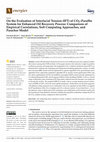
Energies
Carbon dioxide-based enhanced oil-recovery (CO2-EOR) processes have gained considerable interest ... more Carbon dioxide-based enhanced oil-recovery (CO2-EOR) processes have gained considerable interest among other EOR methods. In this paper, based on the molecular weight of paraffins (n-alkanes), pressure, and temperature, the magnitude of CO2–n-alkanes interfacial tension (IFT) was determined by utilizing soft computing and mathematical modeling approaches, namely: (i) radial basis function (RBF) neural network (optimized by genetic algorithm (GA), gravitational search algorithm (GSA), imperialist competitive algorithm (ICA), particle swarm optimization (PSO), and ant colony optimization (ACO)), (ii) multilayer perception (MLP) neural network (optimized by Levenberg-Marquardt (LM)), and (iii) group method of data handling (GMDH). To do so, a broad range of laboratory data consisting of 879 data points collected from the literature was employed to develop the models. The proposed RBF-ICA model, with an average absolute percent relative error (AAPRE) of 4.42%, led to the most reliable p...

Journal of Energy Resources Technology
Proper selection of the drilling parameters and dynamic behavior is a critical factor in improvin... more Proper selection of the drilling parameters and dynamic behavior is a critical factor in improving drilling performance and efficiency. Therefore, the development of an efficient artificial intelligence (AI) method to predict the appropriate control parameters is critical for drilling optimization. The AI approach presented in this paper uses the power of optimized artificial neural networks (ANNs) to model the behavior of the non-linear, multi-input/output drilling system. The optimization of the model was achieved by optimizing the controllers (combined genetic algorithm (GA) and pattern search (PS)) to reach the global optima, which also provides the drilling planning team with a quantified recommendation on the appropriate optimal drilling parameters. The optimized ANN model used drilling parameters data recorded real-time from drilling practices in different lithological units. Representative portions of the data sets were utilized in training, testing, and validation of the mo...
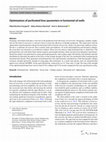
Journal of Petroleum Exploration and Production Technology
Nowadays, horizontal wells play a vital role in the production from thin heavy oil reservoirs. De... more Nowadays, horizontal wells play a vital role in the production from thin heavy oil reservoirs. Designing a suitable completion for this kind of reservoirs is a decisive factor to boost the efficiency of durable production. This study deals with the optimization of perforated liner design for horizontal wells in Sarvak oil reservoir, which is located in the southwest of Iran. Sarvak is a carbonate oil reservoir, but it contains shale and mudstone. To avoid solid production and formation collapse, the screen liner was selected as a cost-effective solution. There were two choices, either perforated liner or slotted liner. The perforated liner was selected by finite element analysis and strength checking, which was proven by laboratory experiments. Sensitivity analysis was performed on various perforated parameters such as phase angle, hole density, hole diameter and hole distribution to determine the pattern of the holes so that enough strength of the liner was maintained while maintai...
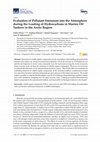
Journal of Marine Science and Engineering
Emissions of volatile organic compounds into the atmosphere when loading oil or petroleum product... more Emissions of volatile organic compounds into the atmosphere when loading oil or petroleum products into tankers are strong environmental pollutants. Given the increase in oil transport by sea and the development of Arctic routes, humanity faces the task of preserving the Arctic ecosystem. Vapor recovery units can limit the emissions of volatile organic compounds. However, it is necessary to estimate the emissions of oil and petroleum products vapors. This article offers two methods for estimating emissions of volatile organic compounds. In the analytical method, a mathematical model of evaporation dynamics and forecasting tank gas space pressure of the tanker is proposed. The model makes it possible to estimate the throughput capacity of existing gas phase discharge pipeline systems and is also suitable for designing new oil vapor recovery units. Creating an experimental laboratory stand is proposed in the experimental method, and its possible technological scheme is developed.
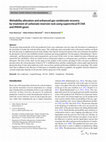
Journal of Petroleum Exploration and Production Technology
The pressure drop around the well in the production from a gas condensate reservoir causes the fo... more The pressure drop around the well in the production from a gas condensate reservoir causes the formation of condensate in the area before it reaches the well and surface space. This condensate and occasionally water in the porous medium can block the well and create an additional pressure drop. Studies show that the chemical treatment of this area eliminates the problem by altering the reservoir rock wettability toward a moderate and strong gasphilicity. For this purpose, fluoropolymers-, fluorosurfactants-, and fluorochemicals-coated nanoparticles can be used. In this work, we have studied two types of fluoride gas namely R134A and R404A, which are widely used in refrigeration industry as refrigerant gases, perfumery, and industrial detergents. The basis of this study was the aging of rock samples in thin sections and plugs in these two gases at different pressures above the critical pressures of them at 70 °C at different times and then conducting the contact angle experiments by ...
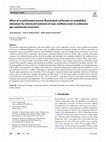
Petroleum Science
The pressure drop during production in the near-wellbore zone of gas condensate reservoirs causes... more The pressure drop during production in the near-wellbore zone of gas condensate reservoirs causes condensate formation in this area. Condensate blockage in this area causes an additional pressure drop that weakens the effective parameters of production, such as permeability. Reservoir rock wettability alteration to gas-wet through chemical treatment is one of the solutions to produce these condensates and eliminate condensate blockage in the area. In this study, an anionic fluorinated surfactant was synthesized and used for chemical treatment and carbonate rock wettability alteration. The synthesized surfactant was characterized by Fourier transform infrared spectroscopy and thermogravimetric analysis. Then, using surface tension tests, its critical micelle concentration (CMC) was determined. Contact angle experiments on chemically treated sections with surfactant solutions and spontaneous imbibition were performed to investigate the wettability alteration. Surfactant adsorption on ...
Petroleum Science and Technology
Environmental Progress & Sustainable Energy
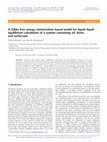
Oil & Gas Science and Technology – Revue d’IFP Energies nouvelles
Accurate and reliable phase equilibrium calculations of microemulsion systems are of great import... more Accurate and reliable phase equilibrium calculations of microemulsion systems are of great importance. This study deals with the thermodynamic modeling of Liquid–Liquid Equilibrium (LLE) of a system including oil (n-decane), brine (containing CaCl2 salt), and ionic surfactant (sodium dodecyl sulfonate). Two models of UNIQUAC and UNIQUAC + Debye–Hückel were used for thermodynamic calculations. The LLE experimental data were utilized to estimate the binary interaction parameters of UNIQUAC model and the adjustable parameter, b, of the Debye–Hückel model. The thermodynamic model calculates the microemulsion phase’s compositions by minimizing the Gibbs free energy of the LLE system using a combination of genetic algorithm and fmincon function in order to prevent local minima. The thermodynamic modeling results show an appropriate agreement with the experimental data. Accordingly, the presented model of this study can be used as a suitable method to investigate the liquid–liquid equilibr...
Separation Science and Technology
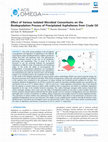
ACS Omega
One of the serious problems in the oil industry is precipitation and deposition of asphaltenes in... more One of the serious problems in the oil industry is precipitation and deposition of asphaltenes in the different oil production stages including formation, wellbore, production tubing, flow lines, and separation units. This phenomenon causes a dramatic increase in the cost of oil production, processing, and transferring. Thus, it seems to be very necessary to use the removing methods for precipitated asphaltenes in different crude oil production and transferring stages. In this study, the ability of microorganisms for biodegradation of precipitated asphaltenes was investigated. For this purpose, four bacterial consortiums were isolated from oil-contaminated soil, crude oil, reservoir water, and oil sludge samples of an oil field located in the southwest of Iran. Based on the results of the designed experiments, by using response surface methodology (RSM) and central composite design, the bacterial consortiums were cultured in the flasks. Three levels of temperatures, salinity, pH, and initial asphaltene concentration as the substrate were considered as the parameters of culture medium and incubated growth mediums for 60 days. The maximum asphaltene biodegradation was 46.41% caused by the crude oil consortium including Staphylococcus saprophyticus sp. and Bacillus cereus sp. at 45°C, salinity 160 g•L −1 , pH 6.5, and 25 g•L −1 initial asphaltene concentration. Also, it was observed that the negative or positive impacts of culture media conditions such as temperature and salinity on asphaltene degradation depended on the type of the available bacterial consortium. The carbon−hydrogen−nitrogen−sulfur analysis showed that carbon, hydrogen, nitrogen, and in some cases, the sulfur in biodegraded samples are less than in control samples. Moreover, Fourier transform infrared analysis indicated that the alkyne groups were less resistant to biodegradation and were eliminated thoroughly after 2 months of incubation. In addition, alkane components were partially removed in treated asphaltene fraction. The parameters of culture medium were optimized by RSM, and besides, their effects on the performance of bacteria in the asphaltene biodegradation process were discussed. The validity of some available kinetic models to describe the behavior of the studied bacteria consortium was investigated, and it was observed that Tessier, Moser, and Contois models accurately predict the values of asphaltenes and biomass concentration at 30, 45, and 60°C, respectively.
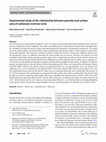
Journal of Petroleum Exploration and Production Technology
Over the time by increasing global demand for source of energy and decreasing hydrocarbon product... more Over the time by increasing global demand for source of energy and decreasing hydrocarbon production from reservoirs, recovery methods have become important. The surface area and porosity are central physical characteristics that highly affect the estimation of original oil and gas in place and understanding the mechanisms incorporating in production. The surface area is the internal surface area per unit of pore volume and determines the amount of space in rocks exposed to injectant during injection operation. The occurrence of fractures system in carbonated reservoirs increases the complexity and decreases the homogeneity; hence, it is difficult to determine the correct surface area of reservoir. Therefore, the existence of a local correlation which relates effective porosity to specific surface area is needed and it can help to estimate effective surface area exposed to chemicals during Enhanced Oil Recovery (EOR) process. In this study, the specific surface area in carbonate reservoir rocks was measured by gas adsorption (nitrogen) method and petro-graphical image analysis. In addition, the effective porosity was determined by a gas porosimeter, followed by plotting specific surface area measured by the Brunauer, Emmett and Teller (BET) method versus specific surface area determined from core scan and calibration curve. According to this calibration curve, a new relationship was developed (with R 2 = 0.92) that could give BET data for a known data of core scan. The relationship between porosity and specific surface area was analyzed statistically and a relationship with accuracy of R 2 = 0.89 was proposed. This relationship was compared with other models such as Pirson and Kotyakhov. Results show that the latter one is more accurate than other models and is more compatible with experimental data (with R 2 = 0.84). The results obtained from the experiment indicate that the specific surface area shows an initial decrease upon increasing of porosity up to 0.2. After this decrease, the curve indicates an increasing trend. Moreover, a novel relationship was developed depending on the specific surface area, porosity and permeability and some constant parameters for carbonate rocks (with R 2 = 0.95).
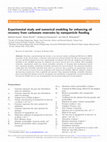
Oil & Gas Science and Technology – Revue d’IFP Energies nouvelles
Nowadays, nanotechnology has become a very attractive subject in Enhanced Oil Recovery (EOR) rese... more Nowadays, nanotechnology has become a very attractive subject in Enhanced Oil Recovery (EOR) researches. In the current study, a carbonate system has been selected and first the effects of nanoparticles on the rock and fluid properties have been experimentally investigated and then the simulation and numerical modeling of the nanofluid injection for enhanced oil recovery process have been studied. After nanofluid treatment, experimental results have shown wettability alteration. A two-phase flow mathematical model and a numerical simulator considering wettability alteration have been developed. The numerical simulation results show that wettability alteration from oil-wet to water-wet due to presence of nanoparticles can lead to 8–10% increase in recovery factor in comparison with normal water flooding. Different sensitivity analyses and injection scenarios have been considered and assessed. Using numerical modeling, wettability alteration process and formation damage caused by entr...

Journal of Petroleum Exploration and Production Technology
Surfactants are used in the process of chemical water injection to reduce interfacial tension of ... more Surfactants are used in the process of chemical water injection to reduce interfacial tension of water and oil and consequently decrease the capillary pressure in the reservoir. However, other mechanisms such as altering the wettability of the reservoir rock, creating foam and forming a stable emulsion are also other mechanisms of the surfactants flooding. In this study, the effects of three commercially available surfactants, namely AN-120, NX-1510 and TR-880, in different concentrations on interfacial tension of water and oil, the wettability of the reservoir rock and, ultimately, the increase in oil recovery based on pendant drop experiments, contact angle and carbonate core flooding have been investigated. The effects of concentration, temperature, pressure and salinity on the performances of these surfactants have also been shown. The results, in addition to confirming the capability of the surfactants to reduce interfacial tension and altering the wettability to hydrophilicity, show that the TR-880 has the better ability to reduce interfacial tension than AN-120 and NX-1510, and in the alteration of wettability the smallest contact angle was obtained by dissolving 1000 ppm of surfactant NX-1510. Also, the results of interfacial tension tests confirm the better performances of these surfactants in formation salinity and high salinity. Additionally, a total of 72% recovery was achieved with a secondary saline water flooding and flooding with a 1000 ppm of TR-880 surfactant.
Korean Journal of Chemical Engineering









Uploads
Papers by Amir H Mohammadi